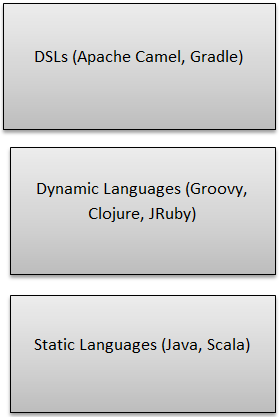Updated May 30, 2023
Introduction to Groovy
Groovy is an object-oriented programming language managed by Apache Software Foundation. It is a java environment compatible and used as a scripting language. It supports functional programming, Metaprogramming, and efficient XML and JSON data processing implemented through JVM. Groovy is syntactically similar to Java syntax. You can integrate Groovy code with existing Java code for enhanced usability. This language is popular in the Java community as it fits static and dynamic programming well. Many developers consider Groovy as an alternative to Java programming in most use cases. It is lightweight and user-friendly for developers.
Understanding
- Object-oriented language.
- Has both static and dynamic capabilities.
- Offers advanced programming concepts.
- They are considered an alternative Java language.
Examples of Alternative Java Languages
- Scala: Which is a statically-typed, object-oriented, and functional language,
- Clojure: This dialect of the Lisp language was created expressly to run on the JVM.
- Kotlin: This statically-typed language runs on the JVM and can compile into either JavaScript or JVM bytecode.
Polyglot programming has arisen in recent years to exploit this explosion in alternative languages for different frameworks. The concept is simple. We might consider more stable, predictable languages at the bottom of the box, or in our case, the framework. This might include static languages like Java or Scala for the JVM world. Moving up the box or into the application code, we might think of more dynamic and flexible languages. In our case, that may be Groovy, Clojure, or even JRuby. At the top of the box, we might look to lightweight DSL (Domain Specific Language)s to build the key business logic into our application on the JVM, including the Apache Camel DSL or Gradle, the build tool. Still, we could also develop our business-specific DSLs to capture the rules of our business domain.
Installation Process of Groovy
Step 1. First, install the SDKMAN tool, which is supported on Linux or OS X. However, if you are working on a Windows machine, you can still follow by installing the Cygwin UNIX emulator. Which can be found at www.Cygwin.com
Step 2. Open the terminal and type the below command, and hit enter
Step 3. Once the execution script is complete, we will source the SDKMAN init script to ensure that everything SDKMAN needs to operate has been initialized in our current session.
Step 4. In the end, we will validate the successful installation of SDKMAN by executing the command “sdk version” and pressing enter, which will prompt SDKMAN to provide its current version.
Step 4. Once you have installed SDKMAN successfully, you can install Groovy. You can do this with the SDKMAN install command.
It depends on the JVM, so you must also ensure you have java installed and available for Groovy to work correctly.
Why is Groovy Used?
It is a very similar syntax to Java; Groovy is easily accessible for Java developers. Most Java syntax is legal Groovy syntax, as it simply takes the existing Java concepts and builds upon them. This gives Groovy a smooth learning curve for a developer who may already be familiar with the Java Language. One of the biggest concerns when a team considers branching out into a new language is that they will lose the investment in the massive proprietary code they have built up over the years.
However, given Groovy’s tight integration with the JVM, you can easily use your existing Java libraries from Groovy.
Finally, Groovy objects extend the same java.lang.Object base object fits very well into the Java object-oriented module that your team may already know. Groovy will feel familiar to a Java team, especially compared to other alternative languages such as Scala or Clojure.
Why Do We Need Groovy?
Groovy works very well in the application development layer, especially web development. Groovy-based frameworks such as Grails are excellent alternatives to Java-based web frameworks such as Stripes or Spring MVC, as Groovy’s dynamic nature makes it very well suited to working with concepts on the web.
It is well suited to building DSLs on top of Java or Groovy frameworks. Though you can also build these DSLs in Java, as we have seen with Apache Camel, Groovy’s expressive nature and flexible syntax allow you to create much more readable DSLs than were ever possible in the Java language.
You can create readable tests using Groovy’s flexible syntax and easily share them with business stakeholders to ensure your app delivers the expected functionality.
The popular Groovy-based testing framework Spock is an excellent example of Groovy’s syntax to create these highly readable tests.
Its lightweight, script-like syntax and tight integration with Java APIs make it an excellent choice for writing small scripts in a JVM environment.
Advantages and Disadvantages of Groovy
Let’s explore some of the well-known advantages and disadvantages of Groovy.
Advantages
- Dynamic typing (enables you to program faster, at least primarily).
- Currying/partial software (enabling you to replicate the function with more than one arguments set).
- Tooling support to get useful APIs applying @DelegatesTo.
- Native associative array/key-value mapping support (you can generate an associative array literal).
- String interpolation (better building among strings showing values).
- Regex’s getting first-class residents.
Disadvantages
- The Groovy plugins (program conclusion, syntax coloring) – around for Eclipse – remains incredibly buggy.
- No base code format for Groovy: This can be a current drawback for Groovy. If you work in a group, this might be a headache: reading the program based on a format and CVS evaluation can be hard; here are a few examples to say.
- You should learn new ideas prefer: closures – which will benefit you once you understand them! Without closures, you cannot apply inner classes in Groovy that are mainly essentially written unit testing.
How will this Technology Help you Grow your Career?
Multinational corporations such as Netflix, Samsung (through Smart Things), Mutual of Omaha, Target, and others widely utilize the Groovy Framework.
Groovy has its good unique places when it comes to utilization; for example, we come across plenty of projects as well as products embedding Groovy to get conveying their organization protocols or simply business logic in an exceedingly understandable style, a lot that also subject matter specialists can author protocols themselves without much support from programmers.
Conclusion
Good memories seem to leave only footprints when you’ve been coding in java or additional OOP languages for a long time.
It creates things much simpler and way less verbose. More features prefer scripting and simply Domain Specific Language features, push Groovy to a new level and provide it with a new look lacking for older languages.
Recommended Articles
This has been a guide to What is Groovy? Here we discussed the Concept, Needs, Understanding, Advantages, Disadvantages, and Installation process of Groovy. You can also go through our other suggested articles to learn more-






